Powering the Future: How Large-Scale Battery Storage Transforms India’s Energy Experience
For customer experience (CX) and employee experience (EX) professionals navigating the complexities of today’s energy landscape, reliable power is a foundational challenge. In many emerging markets like India, energy intermittency and grid instability create ripple effects on business operations and workforce satisfaction. Unplanned outages, fluctuating power quality, and rationing not only disrupt service delivery but also source stress and dissatisfaction among teams and customers alike.
This evolving energy challenge demands new solutions beyond traditional generation. Enter large-scale battery energy storage systems (BESS)—a transformative innovation reshaping how power is delivered, managed, and experienced. With India’s ambitious clean energy targets on the horizon, these systems promise to unlock reliability and sustainability at a scale never before possible.
Large-Scale Battery Storage: The Grid Stability Challenge in India
India aims to reach 500 GW of clean power capacity by 2030, dramatically expanding solar and wind generation. However, renewable power’s intermittent nature makes grid stability an acute challenge. Peak production often happens during midday when demand is low, leading to energy curtailment—wasted green power.
Without robust energy storage, the grid struggles to balance fluctuating supply and demand, risking outages and quality issues. The Central Electricity Authority estimates India will need about 61 GW/218 GWh of energy storage by 2030 to support its green ambitions.
As a result, energy storage is no longer optional—it’s mission-critical to smoothing renewable integration and powering businesses with consistent, predictable electricity.
Adani Group’s Flagship Large-Scale Battery Storage Project: A Game Changer
Adani Group recently announced its entry into battery energy storage with India’s largest BESS project, anchored at its vast renewable energy park in Khavda, Gujarat. The facility will deliver 1,126 MW/3,530 MWh of storage capacity, enough to provide continuous power at full scale for about three hours.
This project, scheduled for commissioning by March 2026, deploys over 700 lithium-ion battery containers integrated with advanced energy management technology. It will ease peak load pressures, reduce transmission congestion, and mitigate solar curtailment. Above all, it enhances grid reliability—directly impacting end-user power experience.
The Adani Group also plans rapid expansion, targeting 15 GWh of storage by 2027 and 50 GWh within five years. This scale of investment signals confidence in energy storage economics and a commitment to sustainable energy leadership.
Transforming Customer and Employee Experiences
Reliable power fundamentally underpins excellent customer experience. For sectors like retail, manufacturing, healthcare, and IT, outages and fluctuations cause disruption, lost revenue, and frustrated customers. Conversely, dependable electricity enhances service delivery, reduces downtime, and builds trust.
From an employee viewpoint, stable power improves workplace comfort and productivity. It reduces stress related to equipment failure or uncomfortable environments. In India, where power interruptions can be frequent, large-scale BESS deployments help create consistent working conditions and support hybrid work models that rely on seamless connectivity.
Thus, the ripple effect of grid stability reaches far beyond the energy sector—powering positive experiences for customers and employees across industries.

Expert Insights on BESS and Energy Transition
Energy sector experts highlight battery storage as central to a resilient, renewable-powered grid. Gautam Adani, Chairman of Adani Group, calls it “the cornerstone of a renewable-powered future” and emphasizes delivering “reliable, clean, and affordable energy solutions at scale.”
Industry analysts note the rapid cost decline in battery storage technologies, with auction prices falling nearly 65% in three years. This price trend helps make large BESS projects more viable and attractive across sectors.
Moreover, integration of advanced energy management systems enables BESS to optimize grid operations, enabling power shifting from periods of low to high demand and ensuring premium power quality.
Practical Recommendations for CX/EX Professionals
- Engage with Energy Providers: Understand how your energy suppliers are adopting storage technologies and how that impacts power reliability. Collaborate to communicate expected improvements to customers and employees.
- Plan for Power Security: Incorporate energy storage adoption into continuity and risk management strategies. Reliable power mitigates critical operational interruptions and protects brand reputation.
- Advocate for Sustainable Practices: Support organizational sustainability goals by valuing investments in clean energy and storage solutions. These advances demonstrate corporate responsibility and resonate with socially conscious stakeholders.
- Leverage Technology: Use BESS advancements enabled by AI and IoT to monitor and optimize energy consumption in facilities. Smart energy management boosts operational efficiency and work environment quality.
- Communicate Transparency: Share updates on energy innovations with your teams and customers. Transparency builds trust and aligns stakeholders around your sustainability and reliability commitments.
Conclusion
Adani Group’s groundbreaking battery storage project marks a major leap for India’s clean energy transition. By stabilizing the grid and ensuring reliable power at unprecedented scale, it reshapes the customer and employee experience landscape across industries. For CX and EX professionals, understanding these developments is key to future-proofing operations, enhancing satisfaction, and aligning with the global sustainability shift.
Battery energy storage is more than an energy sector innovation—it’s a foundational enabler for resilient, customer-centric, and future-ready business models in India’s evolving marketplace.


